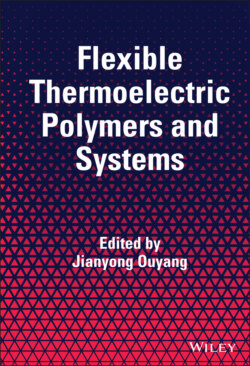Читать книгу Flexible Thermoelectric Polymers and Systems - Группа авторов - Страница 12
1.1 Properties of Thermoelectric Materials
ОглавлениеThermoelectric materials are electronic materials that have charge carrier distributions sensitive to temperature and produce a voltage at the presence of a temperature gradient. In terms of the electrical conductivity, electronic materials can be classified into conductors, semiconductors, and insulators. Conductors like metals usually have a conductivity of >102 S cm−1, while insulators like plastics usually have a conductivity of below 10−7 S cm−1. The conductivity of semiconductors is between those of the conductors and insulators. The conductivity of a semiconductor can be dramatically increased by doping. The different electrical conductivities of these materials arise from their different electronic band structures. As shown in Figure 1.1, conductors have a partially filled band, and the maximum electron energy at the absolute 0 K is the Fermi energy (E F). There is a bandgap between the conduction band and valence band for semiconductors. For a semiconductor, the valence band is fully occupied while the conduction band is completely empty at 0 K in dark. The Fermi level is between the top of the valence band and the bottom of the conduction band for an intrinsic or lightly doped semiconductor. Thermal excitation or light exposure can induce electron transition from the valence band to the conduction band. This leads to increase in the electrical conductivity. The bandgap of insulators is much larger than semiconductors. Insulators always have very low conductivity because temperature or light cannot usually excite the electrons from the valence band to the conduction band.
Figure 1.1 Band structures of (a) conductors, (b) semiconductors, and (c) insulators.
In terms of the energy band structure, the conventional conductors are metals or heavily doped semiconductors that can have the Fermi level higher than the minimum of the conduction band or lower than the maximum of the valence band. Some charge‐transfer organic salts, intrinsically conducting polymers, multi‐walled carbon nanotubes (MWCNTs), single‐walled carbon nanotubes (SWCNTs) with certain chirality, graphene, and MXenes can have partially filled band structure, and they are thus conductors. The conventional semiconductors include Si, Ge, and compound semiconductors. Conjugated organic compounds and conjugated polymers in neutral state are considered as organic semiconductors. Single‐walled carbon nanotubes can be semiconductive or metallic depending on the chirality.
Apart from the electrical conductivity, the Seebeck coefficient and thermal conductivity are important parameters for thermoelectric materials. The thermoelectric performance of a material is usually characterized by the dimensionless figure of merit (ZT),
where S is the Seebeck coefficient, σ is the electrical conductivity, T is the absolute temperature, and κ is the thermal conductivity. S2 σ is called the power factor. To have a high ZT value, the thermoelectric material should have a high power factor and a low thermal conductivity. Because thermoelectric polymers or organic molecules usually have very low thermal conductivity, the power factor is the important parameter for their thermoelectric performance.
Although metals can have high electrical conductivity, their Seebeck coefficient is usually quite low. Intrinsic semiconductors can have high Seebeck coefficient but low electrical conductivity. Hence, both of them are not good thermoelectric materials. The conventional thermoelectric materials are inorganic semiconductors or semimetals such as BiTe. They can have high Seebeck coefficient and high electrical conductivity. But their high thermal conductivity is a big concern. Thus, effort in improving the thermoelectric performance of inorganic materials has been focused on lowering the thermal conductivity. Because of low intrinsic thermal conductivity, high mechanical flexibility, and low fabrication cost, organic thermoelectric materials have been gaining increased attention [1–4]. The organic thermoelectric materials are usually conducting polymers or doped conjugated organic molecules. Figure 1.2 presents the chemical structure of some representative conducting polymers. The Seebeck coefficient of organic materials is usually lower than their inorganic counterparts by about one to two orders of magnitude. To achieve high thermoelectric performance, it is important to improve the Seebeck coefficient and/or the electrical conductivity of organic thermoelectric materials.
To develop materials with high thermoelectric properties, good understanding in the Seebeck coefficient, electrical conductivity, and thermal conductivity is needed. Although the knowledge acquired from the study of inorganic thermoelectric materials is often used, it is not always true for organic thermoelectric materials.
